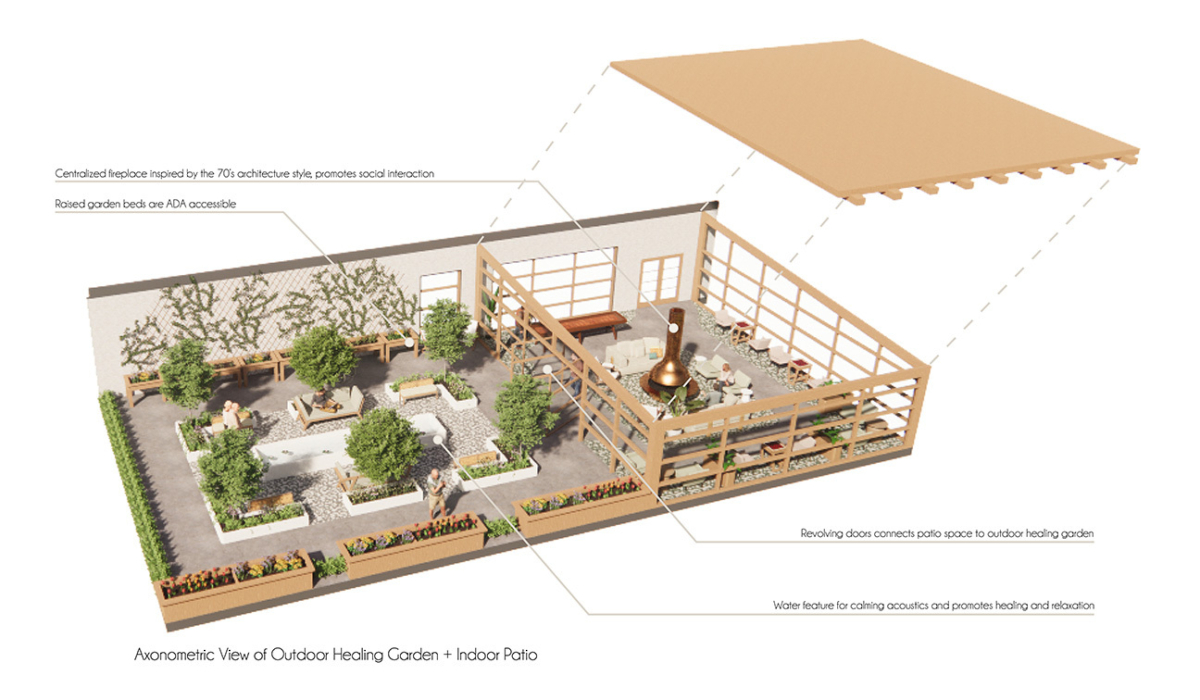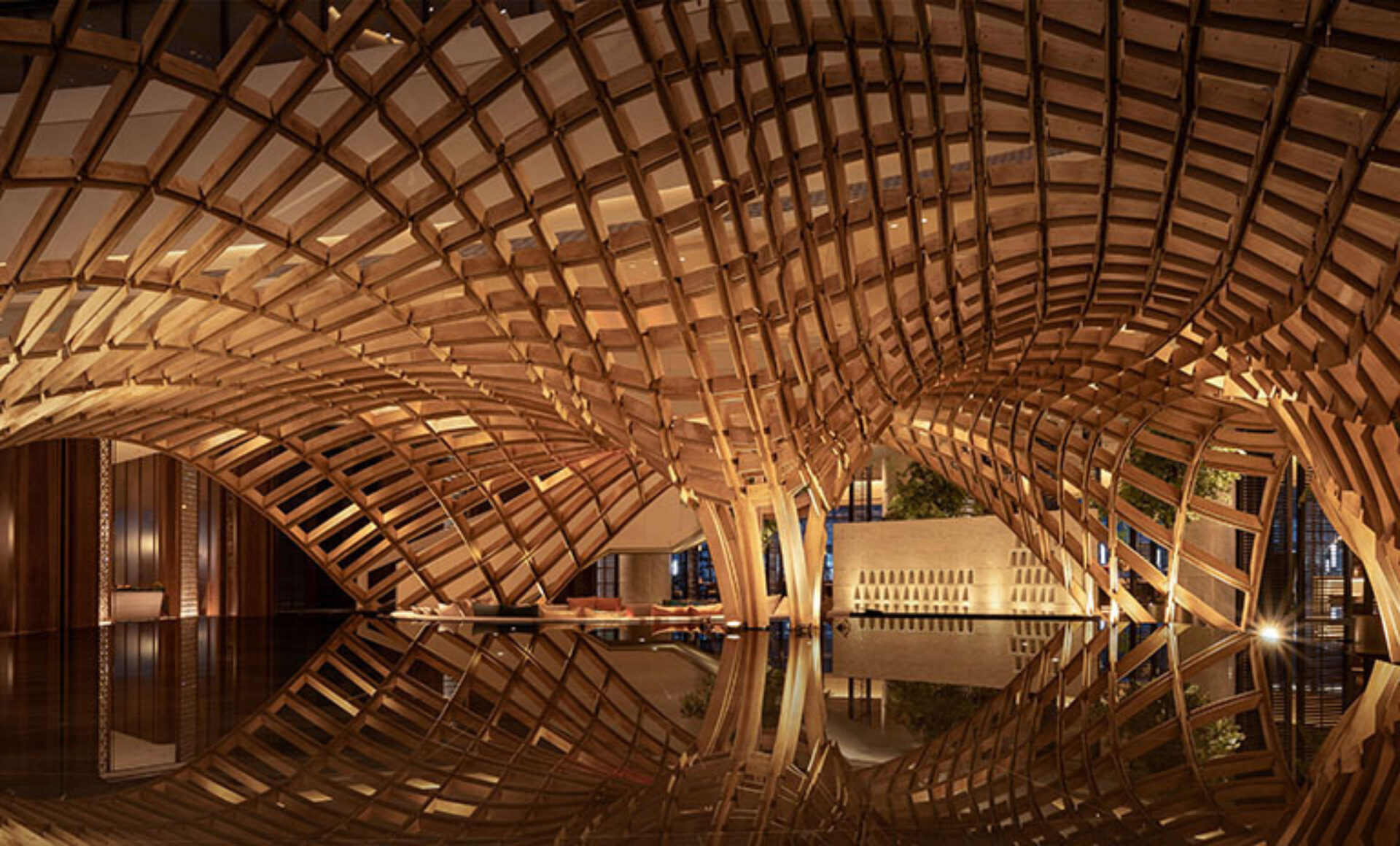The IIDA Student Design Competition (SDC), sponsored by OFS and Carolina, celebrates the talent and fresh design ideas of design students around the world who are currently enrolled in an interior design or interior architecture program or institution. The competition provides emerging professionals the opportunity to showcase their work and gain exposure in the interior design industry.
For the 2023 competition, we invited participants to design a newly constructed assisted living facility with several critical areas. The assisted living facility should include spaces that support healing, restoration, and connection for aging residents with different levels of need. The design should create a seamless resident experience through interior architecture and thoughtful design. Additionally, the design should take into account COVID-19’s effects on this resident population. View the first, second, and third place projects below, as well as the honorable mention, and join us in congratulating our student participants.
2023 Jurors

Interior Designer and Senior Living Associate, Perkins Eastman

Senior Interior Designer and Professional Associate, HDR

Past President of IIDA NY

National Accounts Director, Healthcare, OFS
WINNERS
First Place:
The Collective
Anna Madison, Hayley Wilson, Abby Roberts | Mississippi State University
The Collective draws inspiration from the quilt—a collection of unique pieces of textiles that are unified to create a beautiful work of art that stands the test of time. The Collective integrates the six human experiences, similar to joining pieces of a quilt together. The six human experiences are the collective moments in someone's life that connect with one's purpose. Physical experiences require interaction with one’s surrounding environment. Mental experience involves training and stimulating the mind. Emotional experiences play a role in the way that one perceives events. Social experiences are a crucial part of basic human needs, involving contact and communication with others. Virtual experiences refer to one’s ability to connect with the world around them through technology. Spiritual experiences are subjective and unique for each resident. These key aspects combined, create a purposeful and fulfilling lifestyle for residents of The Collective. The overall aesthetic of The Collective draws moments of inspiration from mid-century modern design to connect residents with their younger years.
Second Place:
Terrene Assisted Living Facility
Sydney MacMann, Aidan Taylor, Tori Waldbieser | Mississippi State University
Terrene Assisted Living Facility’s primary objective is to create an atmosphere that encourages residents to experience comfort and therapeutic relaxation in the way that suits them best. Both the name and design of Terrene are inspired by the Scandinavian lifestyle principle of Hygge. This tried-and-true concept refers to the feeling of being content within the present moment. Taking inspiration from Scandinavian design principles, Terrene heavily emphasizes curvilinear and bending forms, interior finishes that mimic the natural world, and the implementation of daylighting. Terrene prioritizes preventative care, individualized treatment regimens, and tactile forms of therapy. Design trends that were taken into consideration for Terrene Assisted Living Facility are heavily influenced by the recent pandemic, which gave healthcare professionals insight on how socialization, or lack thereof, affects mental health. Human-centered design is implemented in a way that preserves the dignity of each resident, such as having a clear distinction between staff and resident areas to preserve a sense of residential normalcy. Environmental psychology plays a large role in human-centered design, for example, dimmable lighting is included throughout Terrene for each resident to be able to control their environment.
Third Place:
The CuraBlu Assisted Living Facility
Shraddha Karalkar, Student IIDA | West Valley Community College
The CuraBlu (healing flower) Assisted Living Facility derives its name from the bluebonnet flower which is the official State Flower of Texas. The flower symbolizes beauty, bravery, patience, and pride and is reflected through the interior and architectural elements. The objective behind the designed space is to provide a safe, engaging, and comforting environment to aging people that cultivates hope coming from the word “CuraBlu,” a hope for healing and source of vitality. The space seeks to incubate a nurturing environment for rehabilitation, restoration, and connection through its design elements. The space planning provides various dynamic spaces to the residents where they feel connected and engaged. This research based approach to design an assisted living facility in which the needs of the resident can be customized and tailored to their specific age and physical and cognitive abilities demonstrates the ideal solution and helps promote the safety and psychological well-being of the aging residents.
HONORABLE MENTIONS
The Aquifer
Anna Batalova, Student IIDA, Elizabeth Perry, Paloma Vargas, Ladan Khalvati, Daphne Amarachi Uchechi Chilaka | Texas Tech University
The Aquifer Assisted Living Facility is inspired by the life-giving habitat of the city of Austin's Barton Springs Pool. The goal of the Aquifer Assisted Living Facility is to emulate the considerable ingenuity of Barton Springs, which has continually symbolized the attributes of not only shelter and protection, but of socialization and healing through water. The objective of the Aquifer Assisted Living Facility is to promote rejuvenation, independence, and a sense of security for both the residents and the members of their families. This is achieved through flexibility created in the layouts of the public, resident, and caregiver spaces. Socialization among the residents will be facilitated through the implementation of a variety of recreational areas, and the introduction of indoor, semi-indoor, and outdoor social settings. To enhance the safety and sense of security of every resident without infringing on their autonomy, non-intrusive gates have been discreetly located along each outdoor space. Overall, the Aquifer Assisted Living Facility creates a seamless resident experience through thoughtful interior and environmental design that supports healing, restoration, and connection for aging residents.
The 2024 IIDA Student Design Competition is scheduled to open for submissions January 2024.


















































